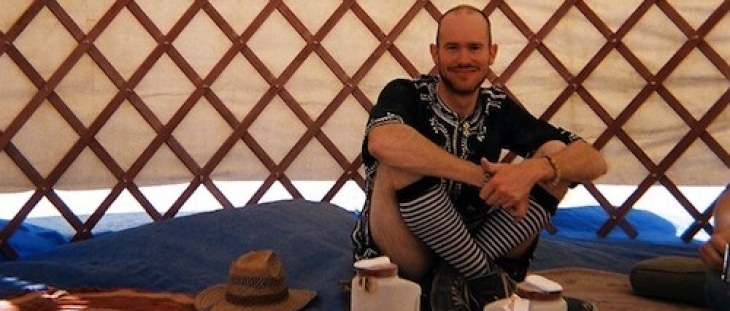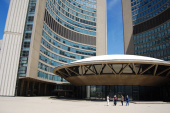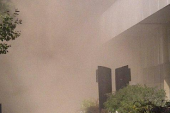
Photo: Ratha Grimes via Flickr In the end, it came down to a single yurt. The police, who were going to great lengths to smile at everybody, had formed a circular cordon around the library yurt, wherein a sole resister had holed himself up. After what may have been the world’s longest police negotiation with an unarmed man in a yurt, he was arrested with equal parts delicacy and manpower. The half-dispersed crowd stood around, occasionally mustering a chant of “Don’t hurt the yurt!” The yurt was not hurt. The unions had paid good money for it. It was dismantled – colourful outer skin, construction grade weather-proofing, a hairy inner layer and then, a wood skeleton – and piled into a rental truck that had been backed onto the lawn. All the other tents had already been carted off. One guy had climbed a tree, and was yelling “Occupy your trees! Occupy your trees!”, to little evident effect. Workers crowbarred up the wooden crates that the yurt had sat upon, and crushed them in the back of a garbage truck. Across the park, police processed their handful of detainees on the spot. A young woman slid in to rake up the leaves that remained, and Occupy Toronto – a day earlier, a roiling little community – was gone. On the surface, we’d seen so much of it before: the willy-nilly assemblage of activists, the jumble of beliefs and demands, the cocktail of idealism and grievance. Yet Occupy managed to become more than the sum of its parts. Far from the camp-site, I kept hearing comfortable members of the middle class who, in other years, would have rolled their eyes and changed the channel, voicing their support. Now that the camp is gone, can Occupy survive? Perhaps the best way to understand Occupy wasn’t to look at it too closely. Up close, it was too easy to get caught up in the vivid details: the cacophony, the squabbles, the characters, the “characters,” the prayerful quality of the assemblies, in which hundreds would amplify a single speaker’s voice by repeating it en masse, phrase-by-phrase, sounding very much like the congregants in St. James Cathedral above them. In theory, this was a democratizing action. In practice, one wondered if mass-recitation had the same pacifying effect on anarchists as Anglicans. In New York City, Zucotti Park had been transformed into a solid, malodorous mass of tents, but Occupy Toronto had built an impromptu village, with little cottages, larger structures, common spaces and thoroughfares. The local dog-walkers may have disagreed, but it was an intriguing use of public space. As attractions go, a semi-autonomous self-policing quasi-anarchist state is a pretty good way to animate a park. Like the Occupy movement in general, the encampment was a Rorschach blot. A visitor – especially a visitor with a column to write – could find evidence for pretty much any take they wanted. If you wanted to find a wingnut so you could complain it was populated by wingnuts, you could. If you wanted to find an achingly earnest, itinerant student, so you could complain it was run by the entitled, you could. If you wanted to find an anarchist, so you could wonder what anarchists actually believe (it’s hard to pin down, but it never seems to be anarchy, exactly), there were plenty of those, too. It was a street movement, and it embraced the unruliness of the streets and those who live on society’s fringes. But, of course, it was more than just a bunch of people hanging around in a park. The Occupiers brought with them an entire system of governance, like colonists bent on enacting utopia on virgin shores. One night, not long before the eviction, a squabble broke out between the folks at the south end of the park, who were having a great rumpus around the drum circle, and the folks at the gazebo who were trying to talk strategy. A delegation went down to the drum circle to entreat them to kindly shut up. This was done in the best Occupy spirit. Arguments went back and forth through the “people’s mic,” interspersed with heckles, asides, and furtive thumps from the one guy who wouldn’t put his drum down. The leaders patiently explained that it was late, the neighbors would be upset, and other Occupiers were trying to work. When this didn’t wash, other arguments were trotted out. “We’re prototyping a new society here!” said one young man. “I’m a hippie!” shouted a boomer on the fringes. “I’m not going to take any bullshit!” Insisting on drumming, said another, “is kind of a 1% thing to do.” The definition of “the 1%” was fluid in many senses, but fixed in that it represented the bad guys. The speaker suggested that Occupy values might best be expressed by chanting. There was a bit of humming, and then silence. But the drumming had stopped. There was more than a little gong-show to the process. (It was a drum circle. There may have been an actual gong.) But on the other hand, here were these people, engaging in the messy business of organizing a scraggly assortment of citizens through the most peaceful of means. Consensus-building is not an inherently flawed way of doing business; merely a tricky one. Which brings us back to one of the basic contradictions of Occupy: was this a protest against injustice and inequality, or an experiment in creating a new community? The Occupy answer to this, as to everything else, seemed to be “Both! At the same time! Everything at once!”, no matter how many facepalms this caused in the general populace. This was part of their argument for being allowed to stay in the park on Charter grounds: the values they espoused at the camp, they argued, were an enactment of the changes they wanted to see in society, and so the camp itself was an act of expression. And while this was an intriguing thought, it was an odd move for a protest movement. If they’d been legitimized, it wouldn’t have been an occupation; it would have been a camp-out. And if the Charter recognized the creation of utopian micro-states as an act of free expression, then I would waste no time barricading the Dufferin underpass with Canada Post boxes and declaring the People’s Republic of Parkdalia. This would not be a workable precedent. The St. James encampment couldn’t have been left there indefinitely. But the Occupiers had a point in their arguments: you can’t separate the protest from the camp, because the peaceful, engaging, talkative, inclusive values they espoused there were critical to their broad appeal. Occupy achieved something that the general activist movement has failed at doing for years: it mounted a sustained, peaceful protest that caught the attention and sympathy of the comfortable middle classes. It was formed in a moment of profound popular distress at the way the world is unraveling; it was at once a symptom and cause of unrest. Its presence sparked a million dinner-table conversations, and became a platform for political action in other parts of the system. It’s helped to reopen discussion about bigger items of social consensus that had long-since been assumed to be closed. The fact that Occupy decided to decamp without violence has left its legacy intact. It has social capital to spend, even if it’s short on real estate. But then, I think Occupy had a bigger agenda than occupation: it was building a big-yurt movement. May it continue. Ivor Tossell writes the Urban Studies column for the Toronto Standard. Photography by Brian Labelle and Ratha Grimes via flickr














